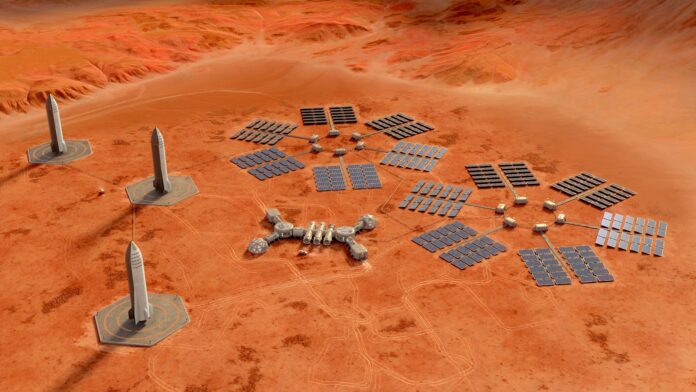Gwynne Shotwell, President and COO of SpaceX in recent weeks stated that her company will get to Mars before the end of the 2020s. She also expects that SpaceX can get to the Moon with NASA’s Artemis program by 2025, and send its Starship on an around the Moon voyage next year.
But NASA’s timelines are different. The Artemis program is seen as a testbed for an eventual crewed mission to Mars around 2040. How can a commercial space company do something that the premier space agency in the world cannot?
Shotwell made her prediction on television despite having yet to launch the Starship on its first maiden orbital test flight which should happen sometime this summer once the Federal Aviation Administration gives SpaceX its blessing. So the aggressive timeline being sold to the public remains hypothetical. But there is no doubt that SpaceX is pushing the envelope using an entirely different innovation and design paradigm. SpaceX has built multiple versions of the Starship to test systems and design. It embraces failure as a means to perfect its final product. That has never been the NASA way.
NASA as a public agency doesn’t do well when something it builds fails. Note the Apollo program fire that killed three. Or the two shuttle disasters that eventually revealed the design flaws of a system and program that killed 14. The consequences of these accidents have made NASA more risk-averse and instead of boldly going forth “a la Star Trek,” the agency is very much an incrementalist. The “giant leap for mankind” that Neil Armstrong proclaimed in July of 1969 is not in the NASA playbook. So 2040 to get to Mars gives the Agency the time to do all the detail work needed to achieve the goal.
The draft objectives NASA has recently released for future lunar and Martian missions contain four categories: 1. transportation and habitation, 2. infrastructure, 3. operations, and 4. science. In this posting, we look at the first three. We can save the science for another day because commercial space operators don’t have science roadmaps in their plans.
Here is what NASA sees as the necessary incremental objectives.
1. Transportation and Habitation
- Develop the cislunar operational capability to orbit the Moon, descend to its surface, and stay there for extended periods.
- Routinely deliver payloads to the surface of the Moon.
- Build and operate systems to live and work on the lunar and Martian surfaces.
- Develop habitation systems for crews to work in deep space for extended durations.
- Build a transportation network between the Earth and the Moon, and the Moon and Mars.
- Develop systems for monitoring the health and providing medical care for missions to the Moon and Mars.
- Develop integrated human and robotic systems for missions to the Moon and Mars.
- Develop systems capable of returning large payloads from the Moon and Mars for scientific purposes.
2. Lunar and Martian Infrastructure Objectives
- Develop and demonstrate a system that can enter, descend and land on Mars capable of delivering human crews and large cargo payloads.
- Develop a power grid for the Moon and duplicate the effort for Mars.
- Develop lunar to Earth communications, navigation systems, and the tools and technologies to support scientific and industrial needs. Then do it again for Mars.
- Demonstrate autonomous and robotic systems that can do construction, provide transportation, and manufacture the necessities to support both a lunar community and one on Mars.
- Use lunar and Martian materials in-situ to support the development of a sustainable on the Moon, in cislunar and interplanetary space, and on Mars.
3. Operations Objectives
- Develop and test all of the technology necessary for lunar and Martian missions first here on Earth and in Earth orbit, followed by further development in cislunar space and on the surface of the Moon.
- Build a support team on Earth for both lunar and Martian exploration.
- Train crews for extended missions to the Moon and Mars.
- Develop extravehicular capacity for exploring the Moon and Mars.
- Demonstrate integrated robotic systems to support human exploration and habitation of both the Moon and Mars.
- Demonstrate the capability to use materials from the lunar and Martian surface as well as in-space resources to reduce the mass required to be transported from Earth.
The SpaceX Planning Objectives
When you go to the SpaceX website, there are no objectives described in a plan to get from Earth to the Moon and then to Mars. It remains aspirational. Instead, the website describes its commercial space operations, products and services.
SpaceX, as it has from the beginning, continues to advance its technologies through experimentation, preliminary builds, and testing. Its contracts with NASA and launch agreements with numerous other companies feed its revenue stream. The Starlink telecommunications business is becoming a reality and a revenue contributor. Starlink is a blueprint that can be duplicated in cislunar and Martian space.
SpaceX’s commercial crew contract with NASA and its lunar lander contract for the Artemis program are sources of revenue. Likely, the business it currently does in crew and supply missions to the International Space Station will expand as private space station opportunities are realized in this decade.
And as for the Moon and Mars, SpaceX and other commercial space aspirants can wait for NASA to continue to issue requests for proposals to meet the Agency’s objectives. These are always accompanied by NASA seed money to cover some of the development costs.
Once Starship is proven, SpaceX will have made its first giant leap beyond low-Earth orbit. Then will come the Moon, and finally Mars. Although Shotwell says the company will get to Mars this decade, I doubt there will be a crew on board that first Starship as it descends to the surface. But one may soon follow once a bunch of Starships have delivered all the stuff laid out in NASA’s objectives to make it possible for humans to explore Mars in person.
With the bravado that has characterized SpaceX since its beginning, therefore, the company is likely to beat NASA to Mars. Will it be as much as a decade ahead in this new space race? SpaceX has a history of stating milestone dates that tend to slip through the trial and error process that is its development and experimentation paradigm. So we will see if the 2030 date can be met.
















Hi Len. I like this post and largely agree. However, it is likely that SpaceX will reach Mars with cargo well before the end of this decade. Launch windows are 2024, 2026, and 2029.
Reaching orbit & recovering the first stage are likely between this summer & the end of the year. Tanker docking is practically guaranteed & propellant transfer is not particularly difficult. So, beyond LEO with significant cargo will likely be 2023.
SpaceX’s Mega Bay has room for the construction of 10-12 Starships simultaneously. So, by 2024, SpaceX will have dozens of Starship variants (boosters, tankers, depots, lunar Starship, Mars Starship, & P2P).
SpaceX will likely send multiple Martian Starships, spaced out by a couple of days for multiple landing attempts with software corrections after each attempted landing. 2026 Mars Starships will be physically modified to take into account the 2024 landing attempt telemetry. It is likely that, by the end of 2026 they will have the opportunity to attempt a dozen+ Mars landings.
With all of those different attempts, it is likely that they will have succeeded in landing some cargo ships and so will be able to send some crewed Starships in 2029 that will attempt a landing with the 2029 cargo landings going first.
Hi Doug, Before all of what you believe will happen, Starship has to prove itself as new technology. And it has to work repeatedly exceeding the performance successes of the Falcon 9. The windows to get to Mars are set in stone, but SpaceX has had milestone meeting problems in its program to develop reusable rocket systems. And it still has to deal with the trials and hazards of a voyage into Deep Space. Whereas cargo can probably be sent and robots can autonomously create conditions on Mars for a human crew to land and stay, the single remaining challenge beyond all that you have described will be addressing the survivability of those who take the voyage.